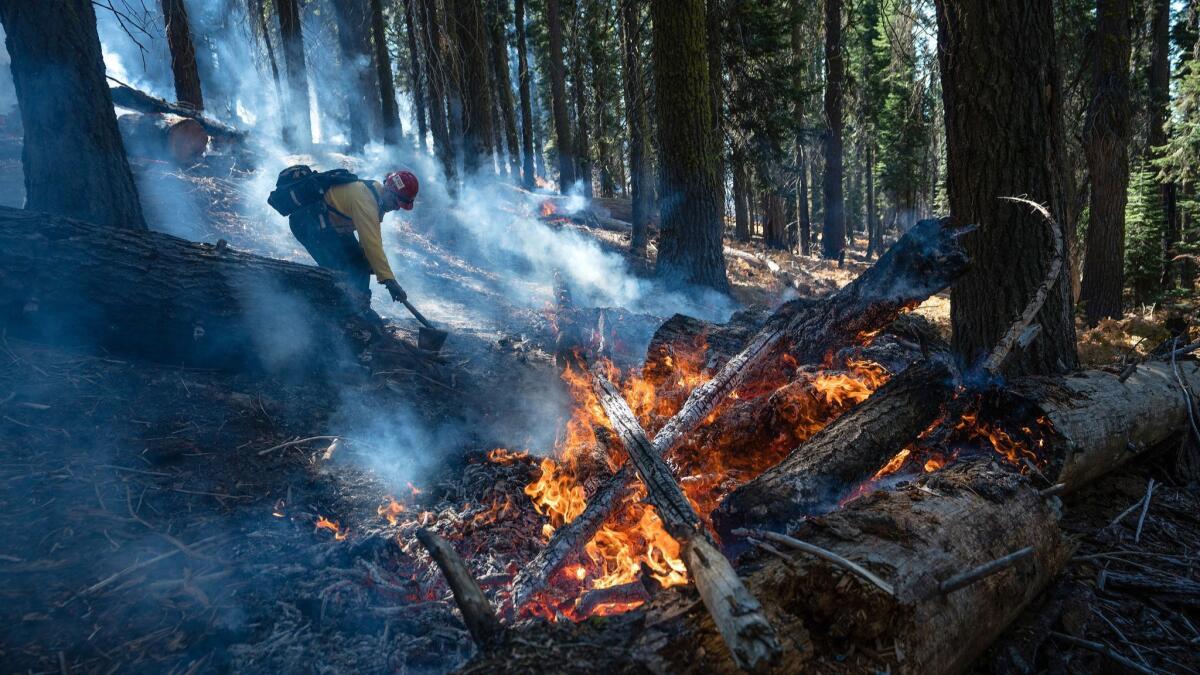The West has many wildfires, but too few prescribed burns, study finds

- Share via
Reporting from Washington — President Trump has laid the blame for out-of-control California wildfires on the state’s “gross mismanagement” of its forests. Former Interior Secretary Ryan Zinke pointed the finger at “environmental terrorist groups.”
But according to a new study, the federal government is not doing enough to control the threat of wildfire in the West.
Despite years of scientific research pointing to prescribed or “controlled” burns as a successful method of clearing brush and restoring ecosystems, intentional fire-setting by federal agencies has declined in much of the West over the last 20 years, the study found.
“This suggests that the best available science is not being adopted into management practices, thereby further compounding the fire deficit in the western U.S. and the potential for more wildfire disasters,” the report warns.
Published Wednesday in the journal Fire, the study by University of Idaho researcher Crystal Kolden analyzed prescribed burns set between 1998 and 2018 by a handful of federal land management agencies, most of which are under the Interior Department, as well as state fire agencies.
Over this period, the amount of land burned each year nationwide increased by about 5%. But almost all of that uptick took place in the southeastern U.S.
In the West, including Northern and Southern California, where climate change and drought have worsened the risk of wildfire, the use of prescribed burns decreased or plateaued. In the Great Basin, a region that includes most of Nevada, half of Utah, and part of several other states, it dropped significantly.
“This may be one of many reasons why the southeastern states have experienced far fewer wildfire disasters relative to the western U.S. in recent years,” the report noted.
Many factors have contributed to the difference between the regions.
Public attitudes toward prescribed burns in the Southeast are more favorable than they are in the West. Western landscapes pose unique challenges — the topography is more inaccessible, and some areas are too overgrown after years of policies that prioritized putting out fires.
“It’s a difficult place to burn. It can be very dry. There are air quality issues,” said Cassandra Moseley, a University of Oregon professor who has studied wildfire management in the West. “Some states in the West are unwilling to burn.”
When Kolden examined work done by federal agencies, which control vast swaths of land in the West, she found that only one — the Bureau of Indian Affairs — had substantially increased its use of prescribed burns.
Federal money for controlled burns has been “drastically depleted” over the last two decades, according to the report.
The Bureau of Land Management, the National Park Service, the Fish and Wildlife Service and other federal agencies have responded to worsening wildfires by spending millions more on the personnel and equipment needed to extinguish them. That has left little money for controlled burns.
Other than the Bureau of Indian Affairs, no other federal agency spends more than 25% of its fire suppression budget on prescribed burns, the report noted.
In an interview, Kolden said that one of the challenges is that federal agency employees tend to view prescribed burns as excessively risky endeavors for which they could be held personally responsible if the blaze got out of control.
“It’s really hard to convince people they should be doing more prescribed fire and even allocating money for that when you’ve got huge destructive wildfires every year,” Kolden said.
Much of the increase in prescribed burns in the Southeast has been accomplished by state agencies and private landowners. About 70% of all prescribed fires in this region were not carried out by the federal government, according to the study.
A similar trend may be emerging in the West.
Moseley said that in California, Oregon and New Mexico, nonprofit groups, tribes, academics and state agencies have come together to form prescribed fire councils. Land managers and air quality regulators are talking to each other to identify the best times to burn.
In western Oregon, where Moseley lives, she said regulators have stepped up their efforts to communicate with the public to prevent panic at the sight of smoke.
“It’s like we’re in the middle of a conversation,” she said. “We’re making progress but there’s a long way to go.”
More stories from Anna M. Phillips »
More to Read
Get the L.A. Times Politics newsletter
Deeply reported insights into legislation, politics and policy from Sacramento, Washington and beyond. In your inbox twice per week.
You may occasionally receive promotional content from the Los Angeles Times.











